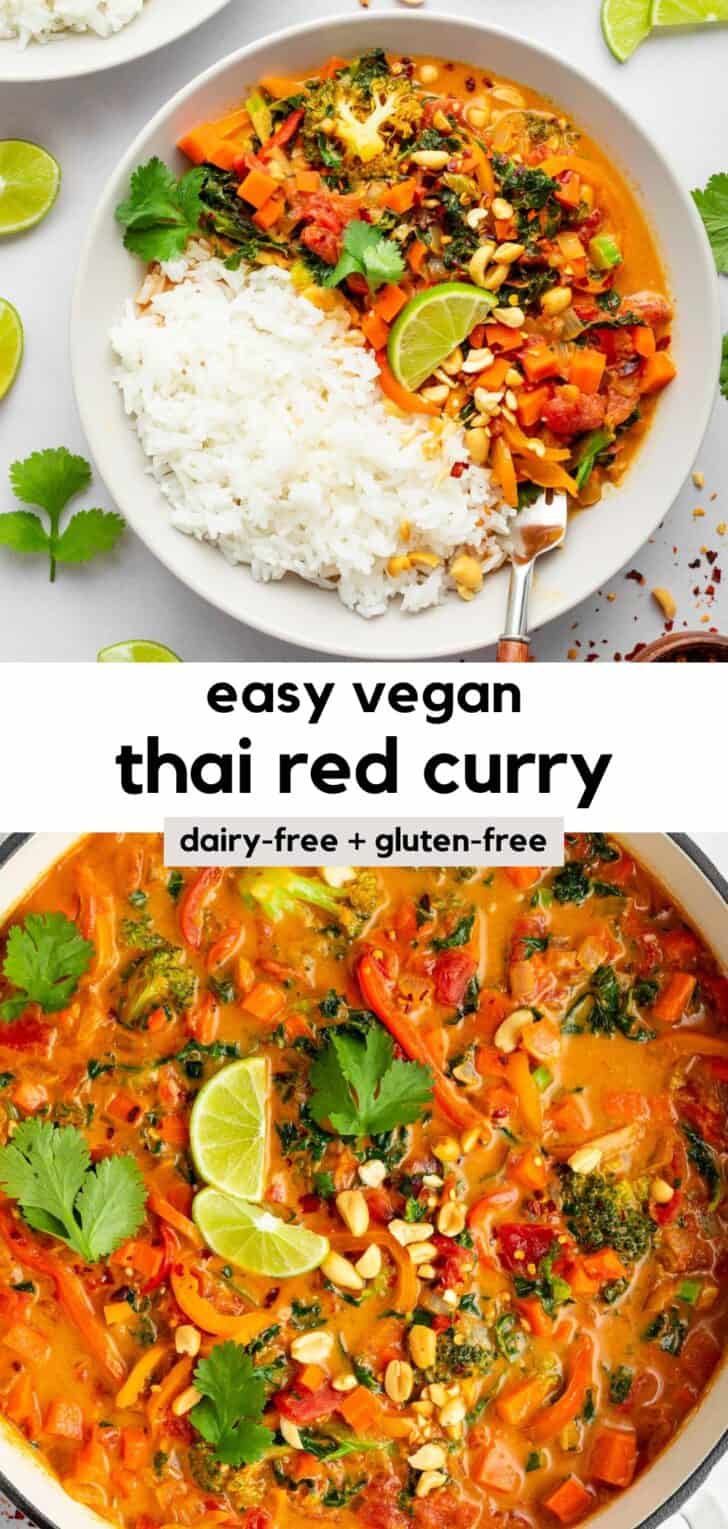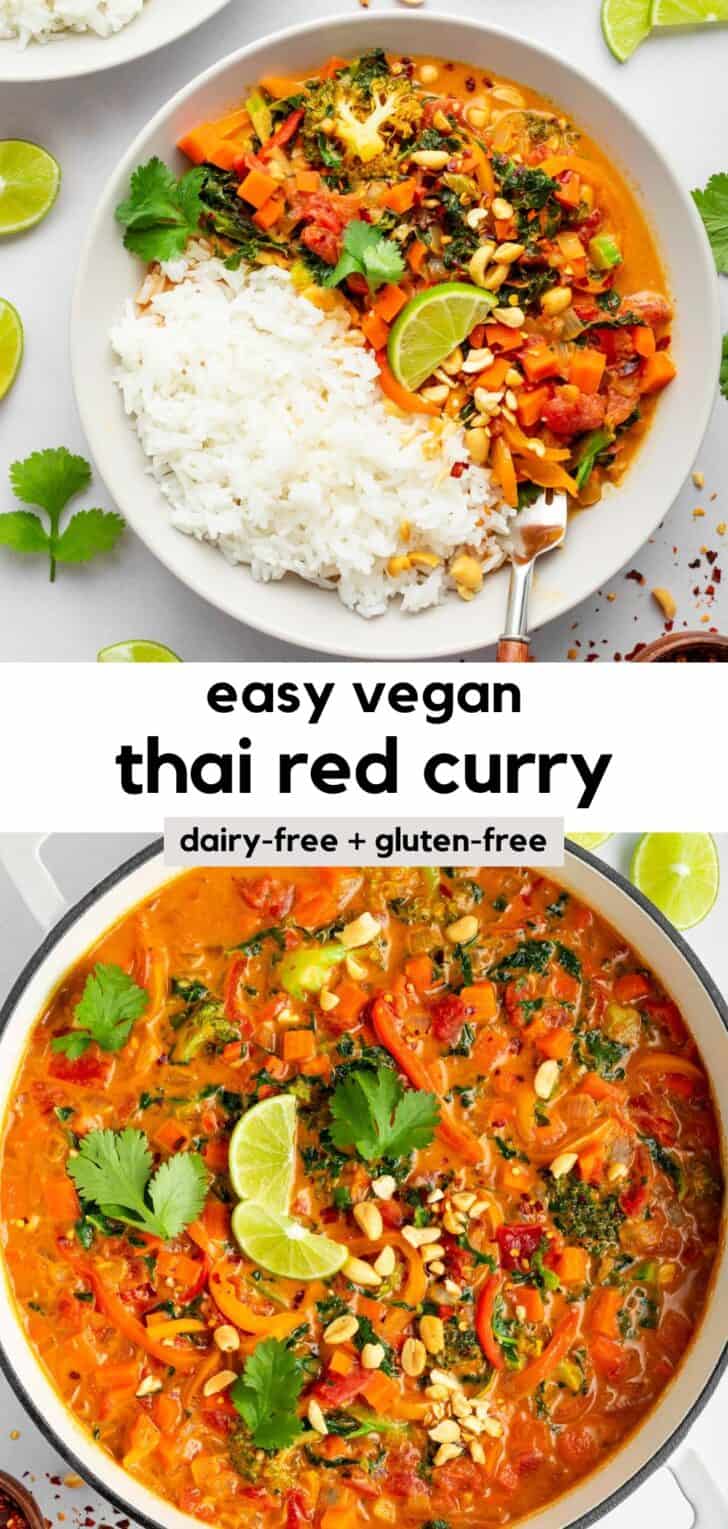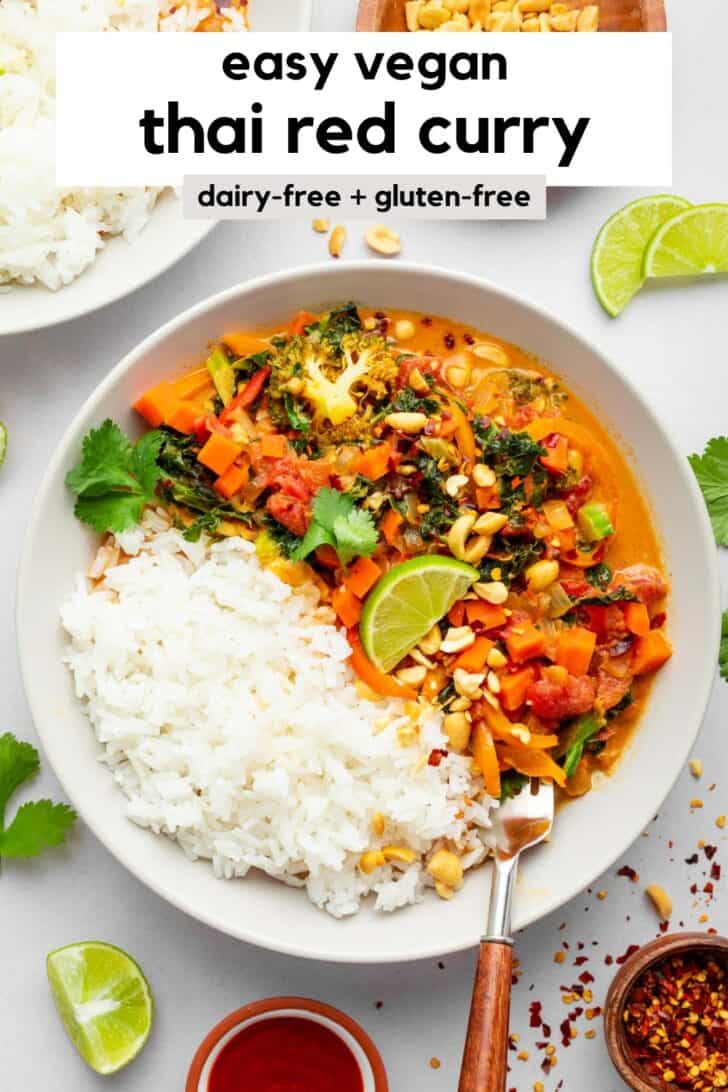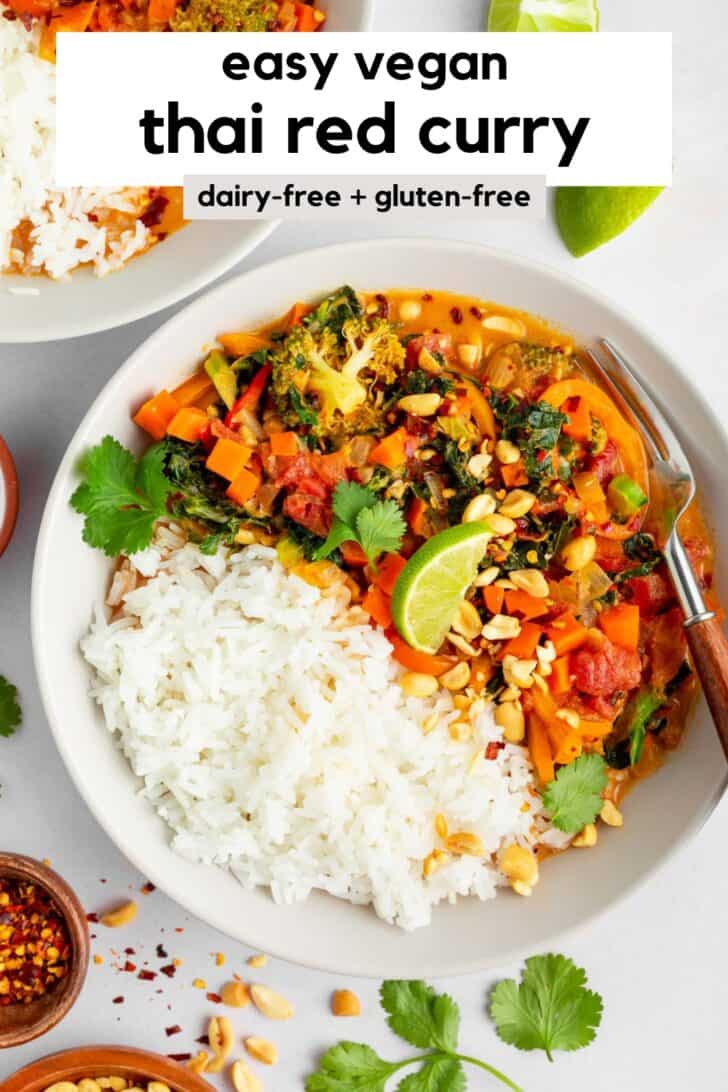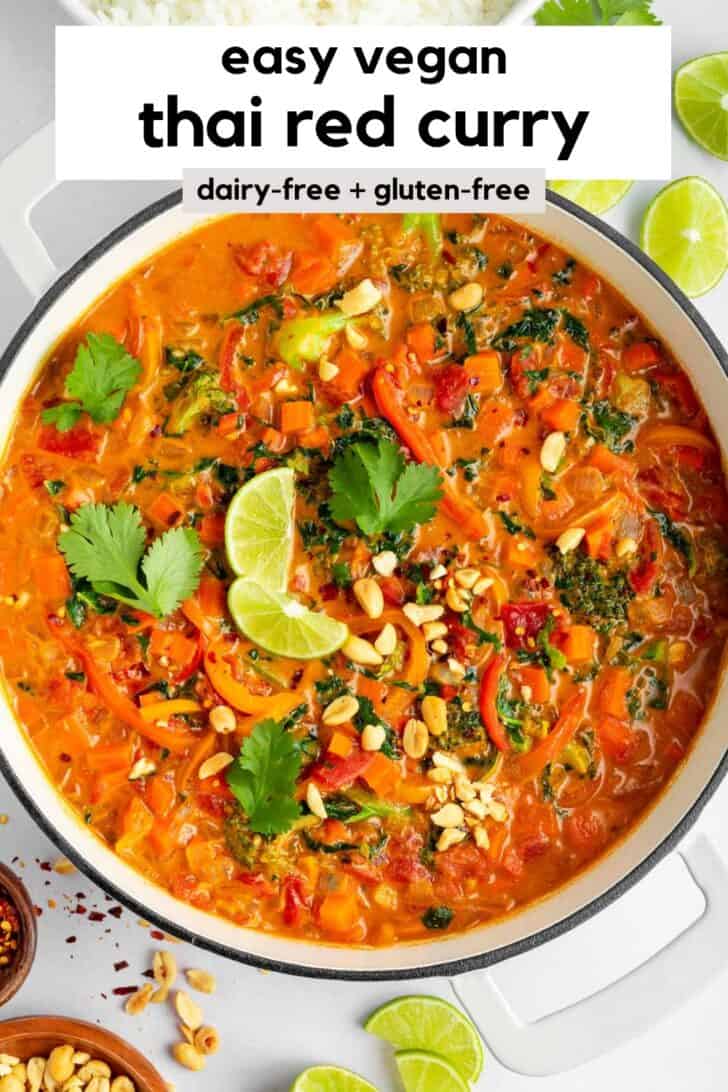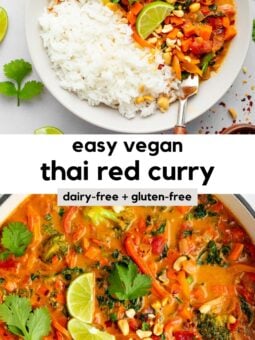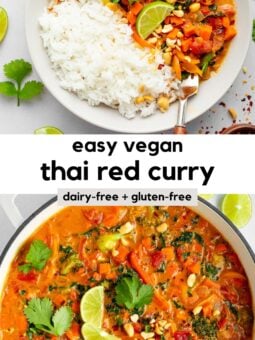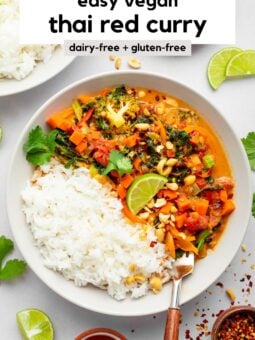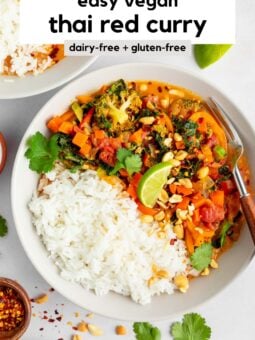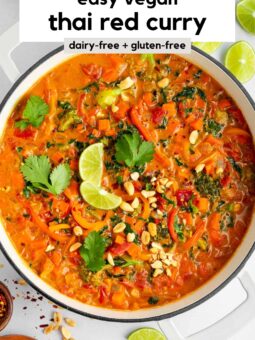Vegan Thai Red Curry
This post may contain affiliate links. Read the affiliate disclosure here.
This vegan Thai red curry is rich, creamy, comforting, and so flavorful! The easy one-pot recipe is packed with vegetables, like bell peppers, carrots, broccoli, and kale. It’s entirely dairy-free, gluten-free, and made in 30 minutes or less. Serve it alongside rice, then garnish with cilantro and roasted peanuts. You’ll be craving this weeknight dinner idea over and over again!
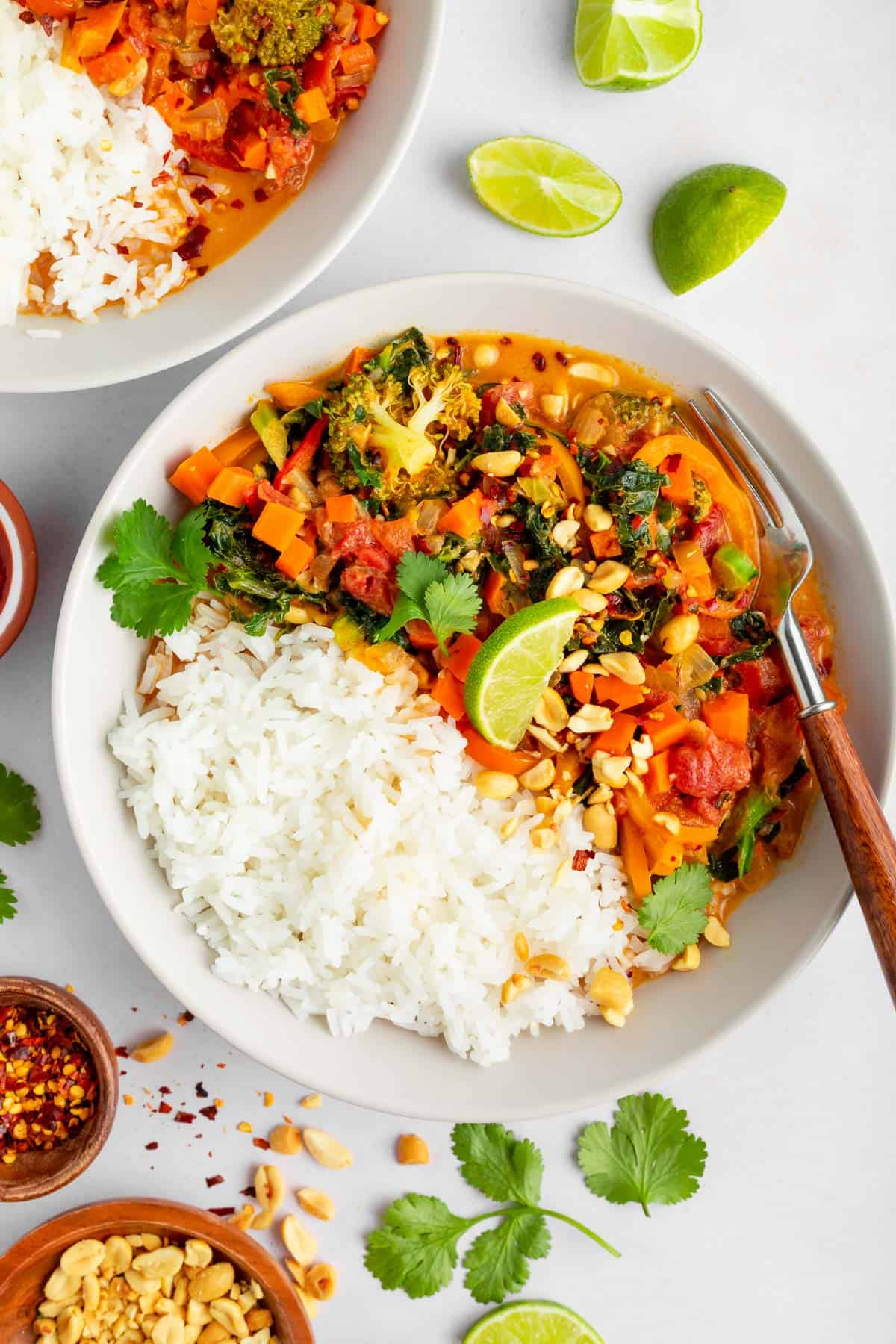
Why buy takeout when you can make a homemade curry that’s healthier, tastier, and ready in no time? This Vegan Thai Red Curry is guaranteed to impress! It’s rich, creamy, spicy, and packed with flavor. When I say it’s better than takeout, I truly mean it.
In my opinion, there is nothing more comforting than a big bowl of curry and rice. It’s my ultimate “hug in a bowl” meal! This particular recipe has everything you need. It’s savory with a kick of heat, ultra creamy due to the coconut milk, and subtly sweet with a touch of coconut sugar.
Additionally, it’s incredibly nourishing because it’s loaded with vegetables. We’ll add red bell pepper, orange bell pepper, broccoli, carrots, and your choice of spinach or kale. Plus, it tastes *even better* the following day because the flavors have more time to marry. Enjoy it as a quick and easy weeknight dinner, then put it to use the next day for a meal prep lunch!
PS: If you love the taste of Thai red curry, you’ll also enjoy my Red Curry Noodles. This is a great option for anyone who loves the flavor, but prefers noodles over rice.
This Thai red curry recipe is:
- Vegan, vegetarian, dairy-free, and gluten-free
- Creamy, savory, spicy, and subtly sweet
- An easy one pot dinner idea
- Ready in under 30 minutes
- Best served with white rice or brown rice
- Truly better than takeout!
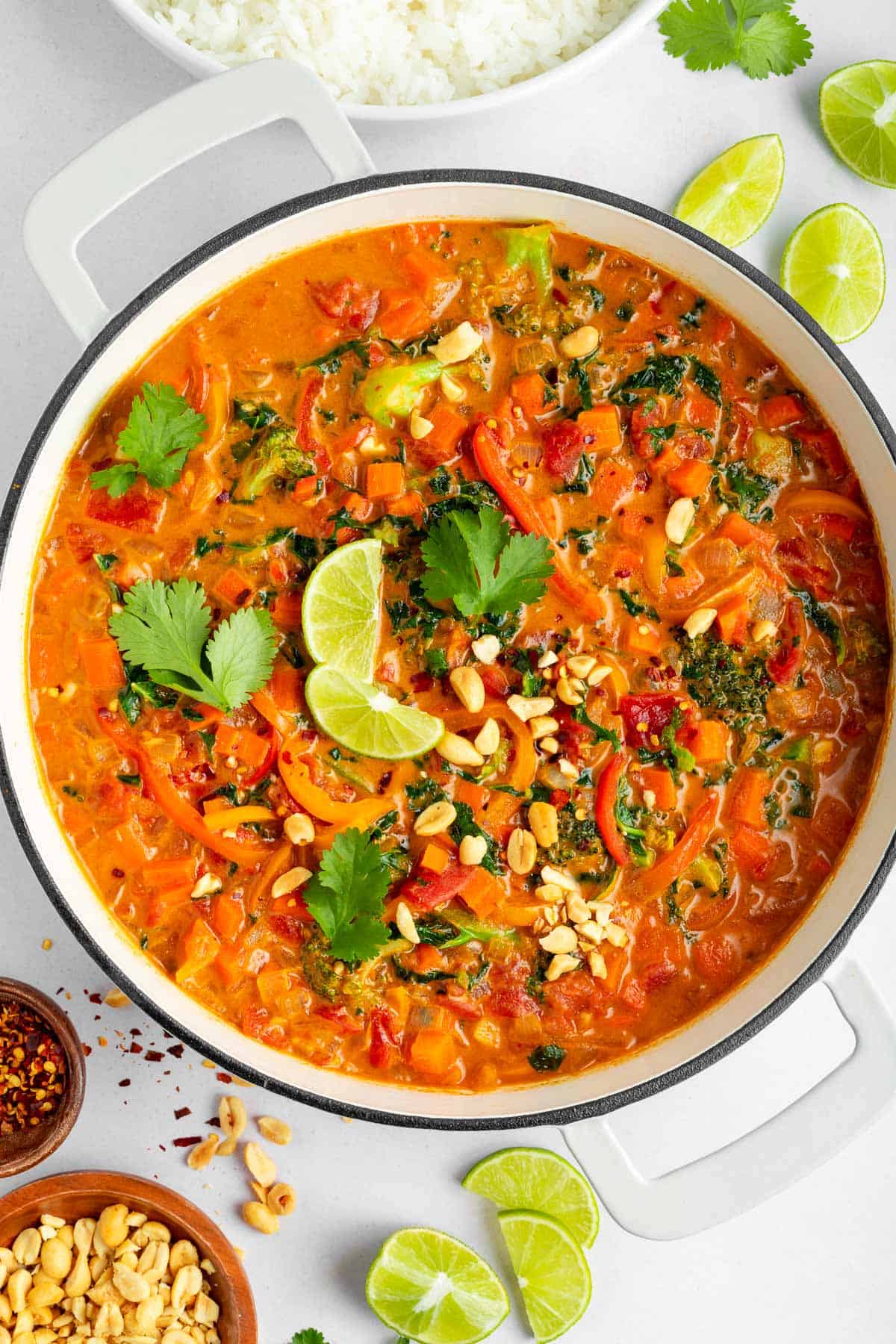
Ingredients in vegan Thai red curry
- Vegetables: We’ll use a variety of veggies for this recipe. In particular, red bell peppers, orange bell peppers, carrots, and broccoli. Near the end, fresh spinach or sliced kale is stirred into the simmering curry.
- Thai red curry paste: A key ingredient! My favorite brand is Thai Kitchen. It’s found in the Asian food section at the grocery store.
- Coconut milk: Authentic curry is typically made with full-fat canned coconut milk. It provides a rich flavor and creamy consistency. Lite canned coconut milk will work too, but the curry will be thinner and a bit less flavorful.
- Diced tomatoes: A can of diced tomatoes adds extra flavor, nutrients, and helps create a vibrant color. Fire-roasted tomatoes would work too if you really love heat.
- Onion, garlic, and ginger: These three ingredients help create a delicious aroma and flavorful curry.
- Coconut oil: While you can use any oil, I prefer coconut oil. Olive oil or avocado oil are other good choices.
- Soy sauce: If you need a gluten-free option, use tamari or coconut aminos instead.
- Coconut sugar: A dash of coconut sugar adds a subtle sweetness.
- Lime juice: Squeeze fresh lime juice over the curry to add a bright and fresh flavor.
- Rice: I recommend serving this vegan Thai red curry with white rice or brown rice, but you can always omit it.
- Garnishes: Garnish the curry with fresh cilantro and roasted peanuts. If you like spicy dishes, add a sprinkle of red pepper flakes and sriracha sauce too!
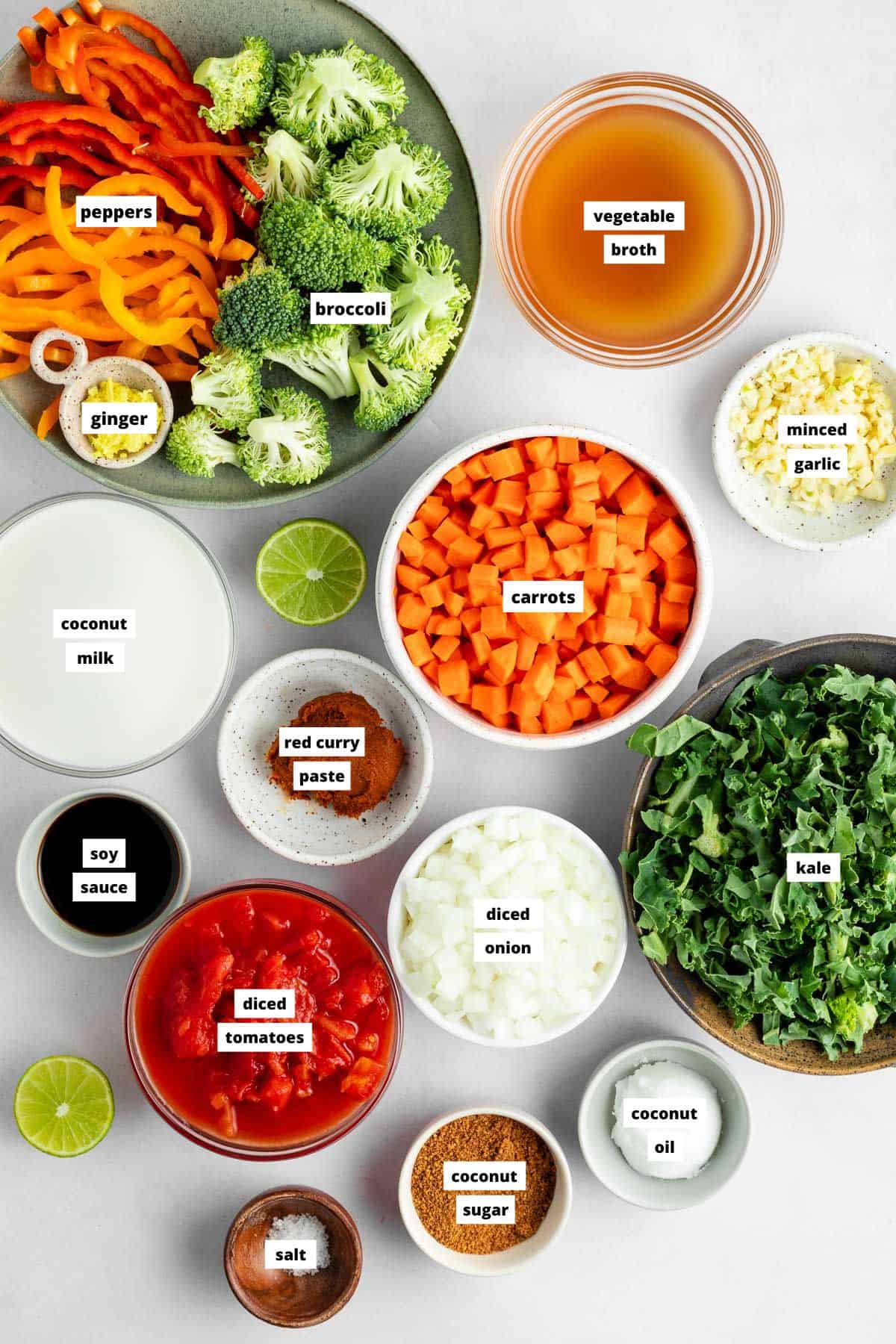
How to make the best vegan Thai red curry recipe
For the full ingredient measurements and step-by-step instructions, scroll down to view the recipe card at the bottom of the page.
First, if you would like to serve it with rice, start by cooking the rice according to the package instructions.
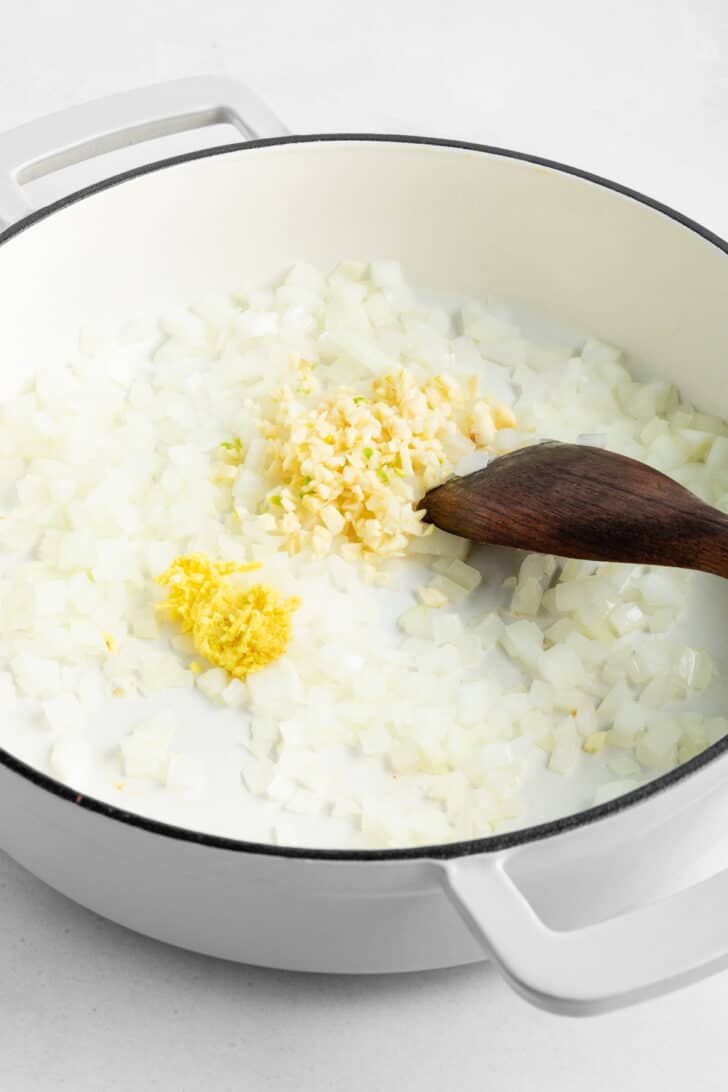
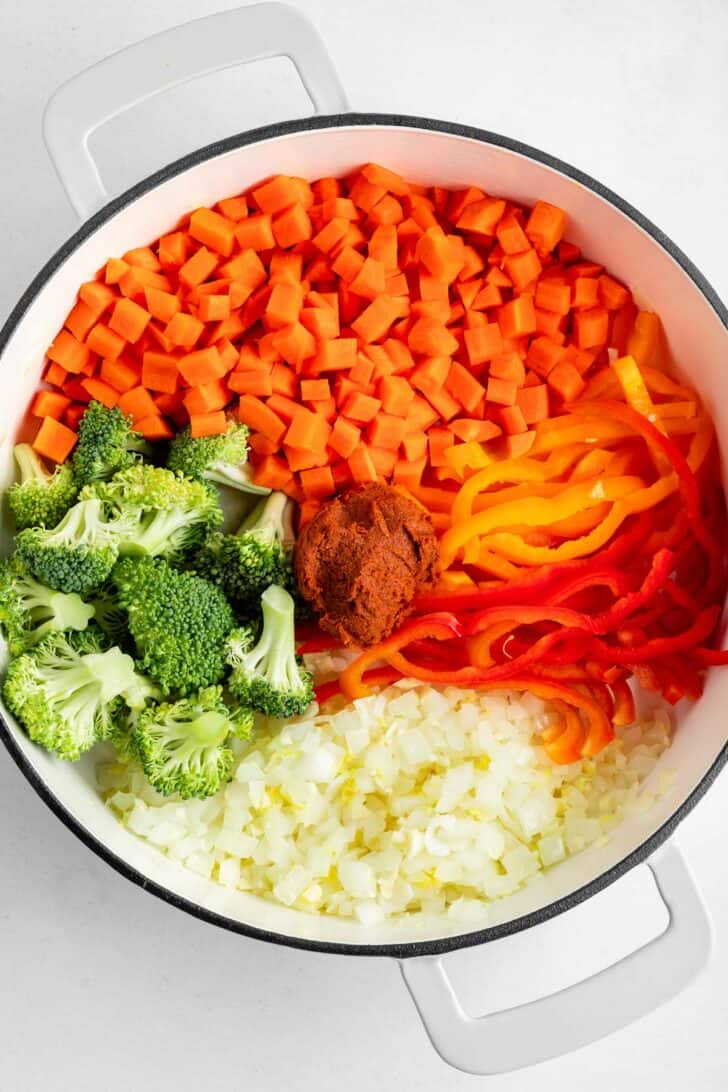
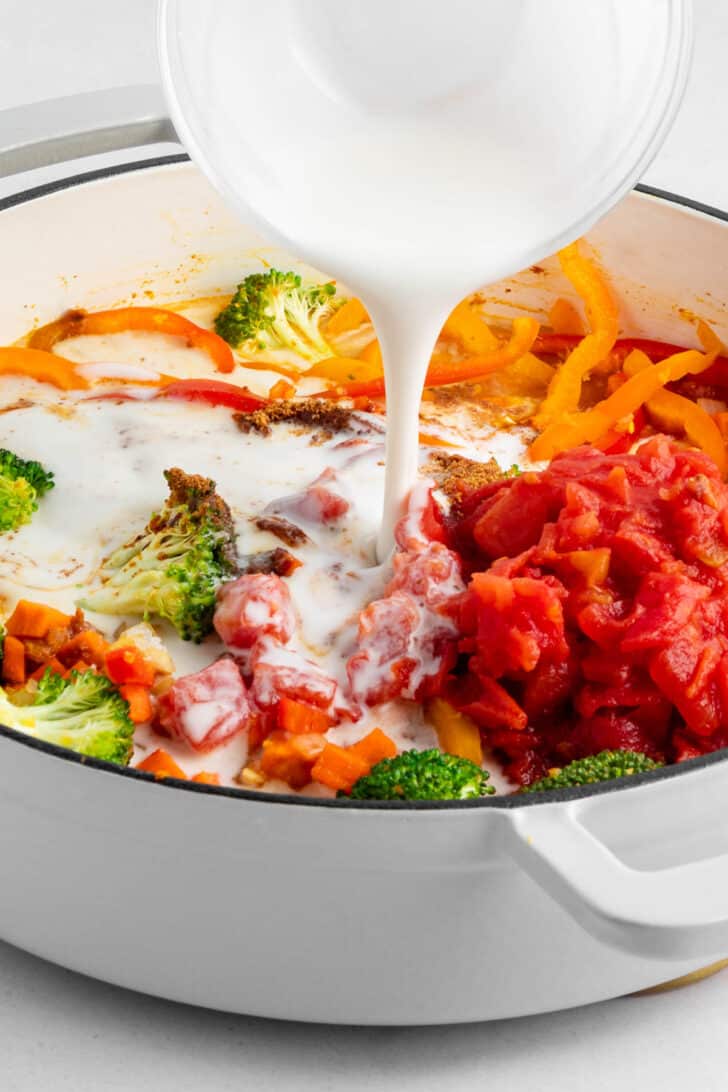
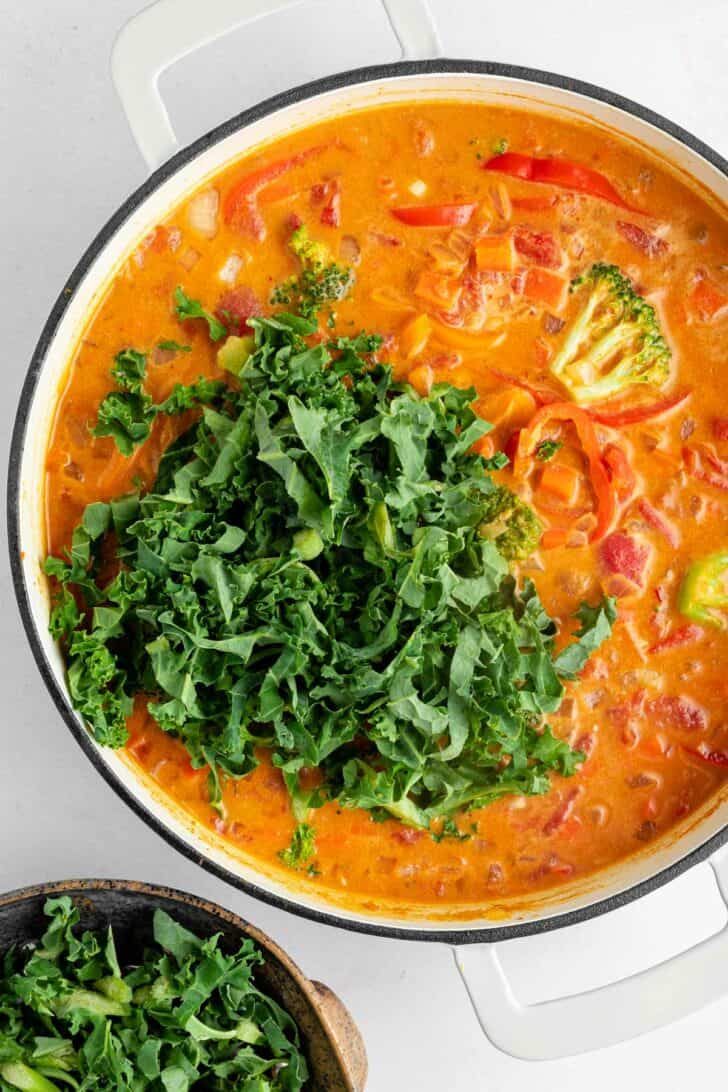
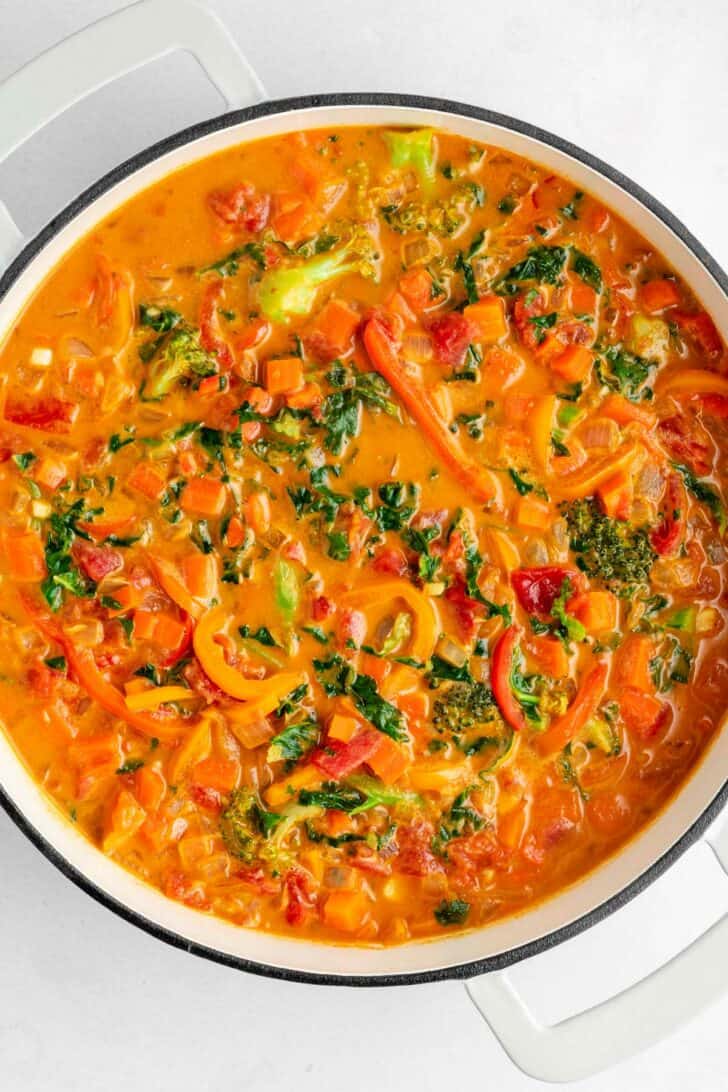
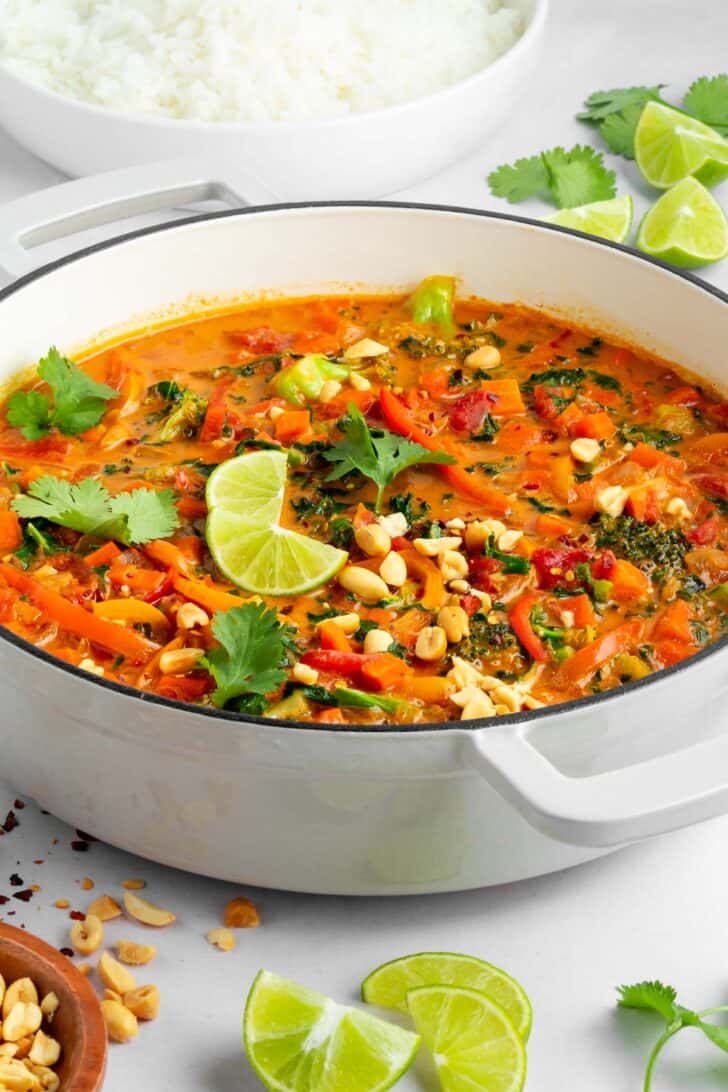
What vegetables go well with vegan Thai red curry?
This Thai red curry is easily customizable. Although the recipe specifically calls for bell peppers, broccoli, and carrots, you can swap them out. Feel free to use anything else you’d prefer instead.
Other delicious options include cauliflower, zucchini, mushrooms, snow peas, butternut squash, and sweet potatoes. If you’re using sweet potatoes, be sure to chop them into small pieces so they cook thoroughly.
What is the best coconut milk for curry?
As the recipe states, you can either use full-fat canned coconut milk or lite canned coconut milk. Both varieties are canned and can be found in the Asian food section of the grocery store.
However, the fat content varies between each kind. I recommend using full-fat coconut milk for homemade curry. It provides the richest and creamiest flavor. However, lite coconut milk will still produce tasty results.
- Full-fat coconut milk: Otherwise known as regular canned coconut milk, the full-fat variety is very thick and creamy. It produces more flavor and a creamier consistency.
- Lite coconut milk: Otherwise known as light coconut milk, this variety is a reduced-fat option. It produces a thinner consistency and lighter flavor.
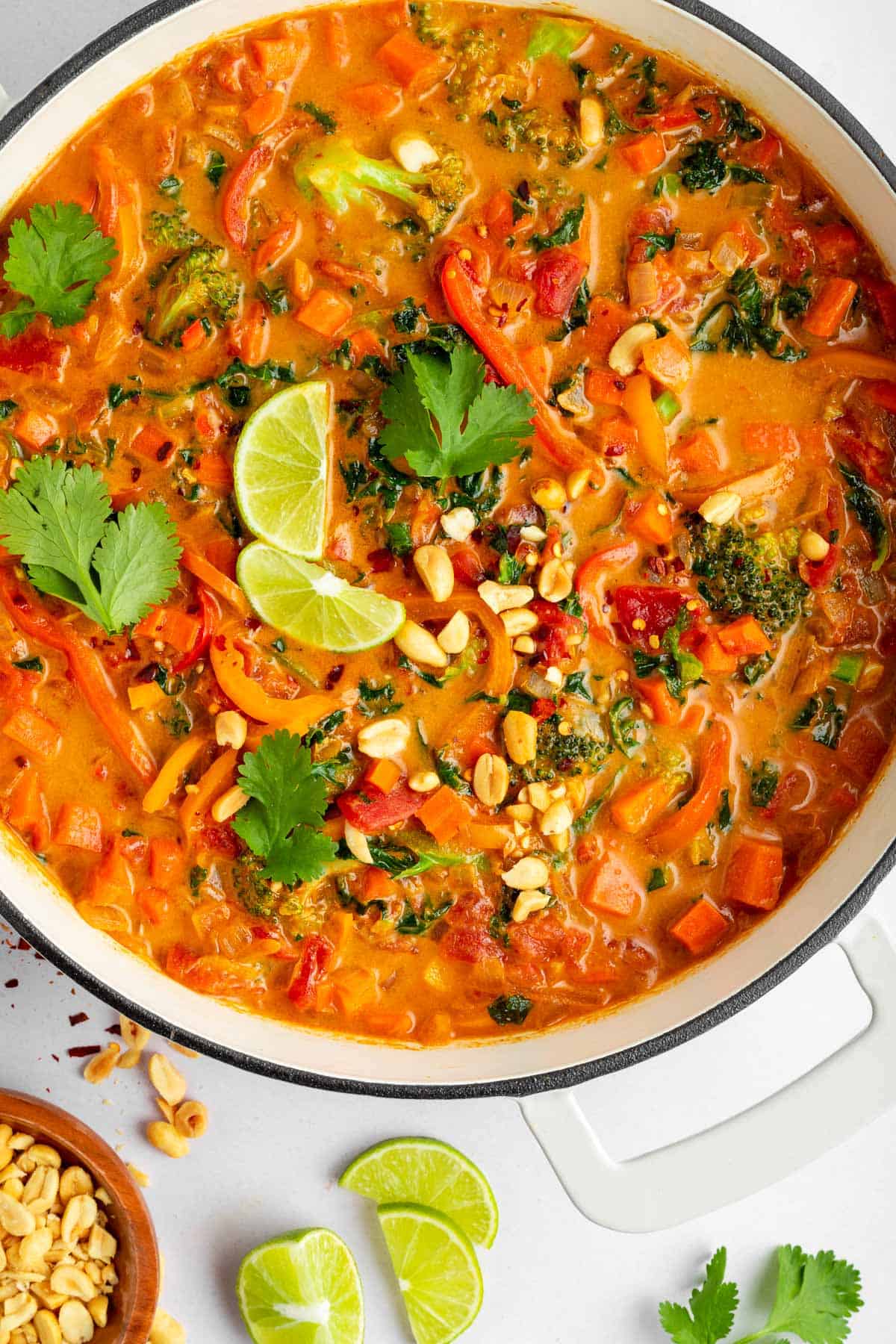
Tips for making the best vegan Thai red curry
Use red curry paste. Thai red curry paste is essential. Do not try to replace it with curry powder. It’s simply not the same! My favorite brand is Thai Kitchen.
Add leafy greens. This is completely optional, but I love to stir in some greens for extra nutrition and added color. During the final few minutes of cooking, simply toss in some fresh spinach or kale. Since the curry is so flavorful, you’ll barely notice the greens are there when you’re enjoying it. (It’s a sneaky way to get some extra veggies in!)
Add protein. If you’d like to add a boost of protein, you can serve it with tofu, tempeh, or chickpeas. If you aren’t vegan or vegetarian, feel free to add chicken instead.
Serve it with rice. For the ultimate cozy and comforting bowl of curry, be sure to serve it with brown rice or white rice. Alternatively, for a grain-free meal, you can serve it over quinoa.
Add sriracha sauce for extra heat. If you’re a lover of hot and spicy curry, add an extra drizzle of sriracha sauce over your bowl. Also, you can sprinkle crushed red pepper on top.
How to store leftovers
Store leftovers inside a tightly-sealed container. Keep inside the refrigerator and enjoy within 3-4 days. You can reheat leftovers on the stovetop or inside the microwave.
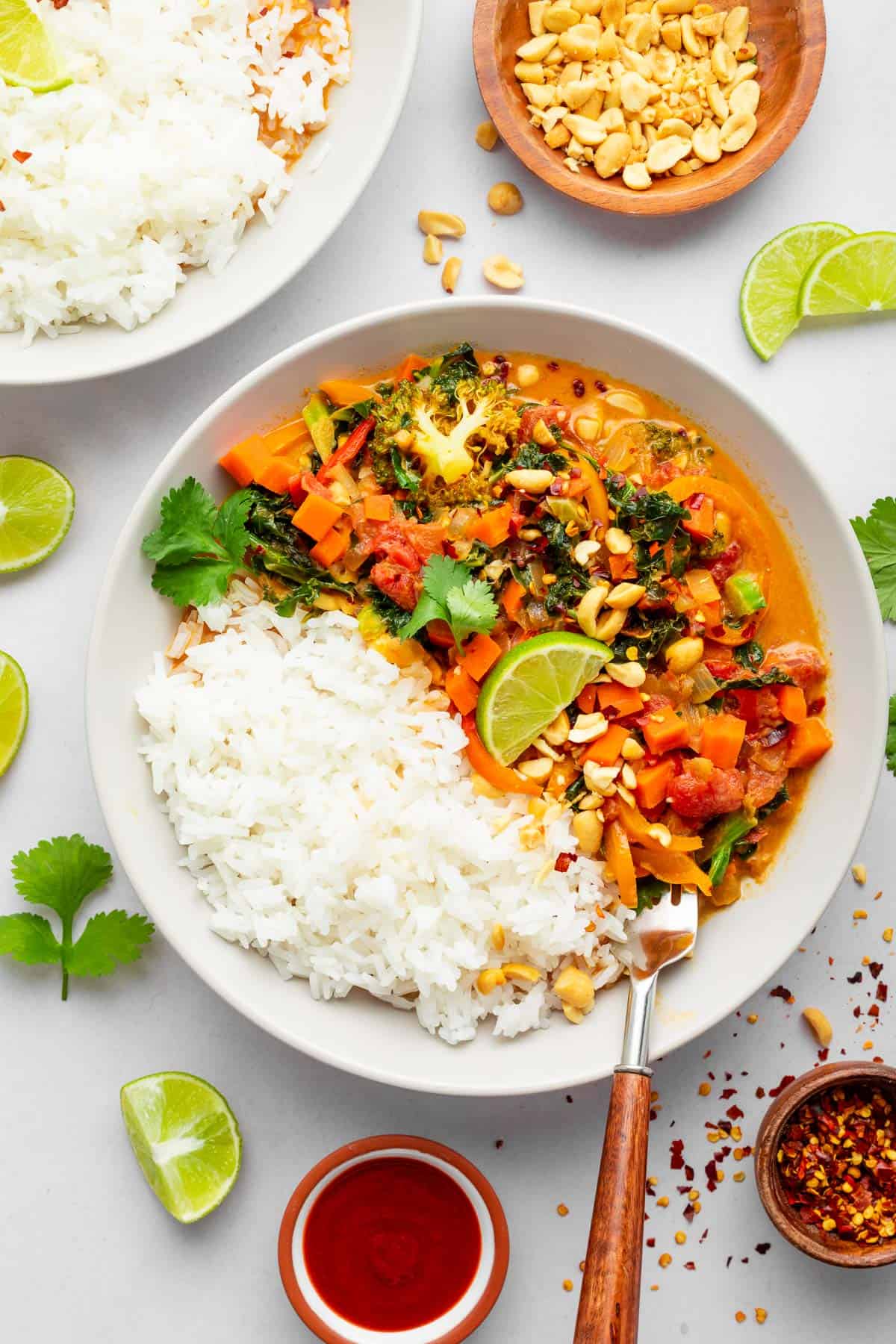
More vegan curry recipes
If you try this Vegan Thai Red Curry, please let me know your thoughts by leaving a rating and comment below! Ready for more? Subscribe to my newsletter or follow along on Instagram and YouTube!
This post was originally published on June 16th, 2020. The post was updated and republished on January 3rd, 2024 (with new photos and an improved recipe).
Print
Vegan Thai Red Curry
- Prep Time: 15 minutes
- Cook Time: 15 minutes
- Total Time: 30 minutes
- Yield: 4 servings 1x
- Category: Dinner
- Method: Cook, Stovetop
- Cuisine: Thai
- Diet: Vegan
Description
This vegan Thai red curry recipe is rich, creamy, savory, and so flavorful! The easy one pot recipe is made in 30 minutes or less. It’s made with coconut milk, red curry paste, and loaded with vegetables (like bell peppers, broccoli, carrots, and kale). It’s dairy-free, gluten-free, and perfect for busy weeknights. Plus, you can enjoy it the next day as a meal prep lunch. Serve it with rice for the ultimate healthy comfort food meal!
Ingredients
Thai Red Curry
- 1 medium yellow onion, diced
- 2 tbsp coconut oil
- 4 cloves garlic, minced
- 1 tbsp finely-grated ginger
- 1 red bell pepper, thinly sliced
- 1 orange bell pepper, thinly sliced
- 3 large carrots, peeled and diced
- 1 cup broccoli florets
- 2 tbsp Thai red curry paste
- 1 14–oz can coconut milk (full-fat or light, but preferably full-fat)
- 1 14–oz can diced tomatoes
- 1 tbsp soy sauce or tamari
- 1 tbsp coconut sugar
- 1/2 tsp salt
- 1 tbsp lime juice
- 3 cups leafy greens (spinach or sliced kale)
For serving (optional)
- 4 cups cooked brown or white rice
- Fresh cilantro, chopped
- Roasted peanuts, chopped
- Red pepper flakes
- Sriracha sauce
Instructions
- If serving with rice, cook the rice according to the package instructions.
- Warm coconut oil in a large pot over medium-low heat. Add diced onion. Cook for 2-3 minutes, stirring frequently, until the onion is translucent and fragrant. Add minced garlic and grated ginger. Cook for 30 seconds, stirring continuously.
- Add the sliced bell peppers, carrots, broccoli florets, and red curry paste. Mix together. Cook until the vegetables start to become fork-tender, stirring frequently, for about 3 minutes. Add the coconut milk, diced tomatoes, vegetable broth, soy sauce, coconut sugar, and salt. Stir to combine.
- Bring the ingredients to a boil (increase the heat as needed). Then, reduce the heat and simmer (partially covered) for approximately 15 minutes. During the final 5 minutes, stir in the spinach or kale. Once the curry has reduced and the vegetables are tender, remove from heat. Stir in the lime juice. Taste and adjust to your preferences, adding an extra dash of soy sauce for more salt or sriracha for more heat.
- Serve curry over the cooked rice. Garnish with fresh cilantro, roasted peanuts, red pepper flakes, and a drizzle of sriracha sauce. Enjoy!
Notes
- Coconut milk: Use canned full-fat or canned lite coconut milk for this recipe. You can find both options in the Asian food aisle of your grocery store. Be sure to vigorously shake the canned coconut milk before opening, in order to stir the contents inside. The full-fat variety will produce a richer and creamier curry.
- How to store: Store leftovers inside a tightly-sealed container in the refrigerator. Enjoy within 3-4 days.
- Nutrition: The nutrition information below reflects the curry made with full-fat coconut milk. If you would like to reduce the calories or fat content, use lite coconut milk instead. Since it is optional, I did not include the rice or garnishes.
Nutrition
- Serving Size: 1 serving
- Calories: 354
- Sugar: 15g
- Fat: 27g
- Carbohydrates: 29g
- Fiber: 6g
- Protein: 6g
This post contains affiliate links. If you make a purchase through one of these links, I earn a small commission at no additional cost to you. I only recommend products I personally use, trust, and love!


